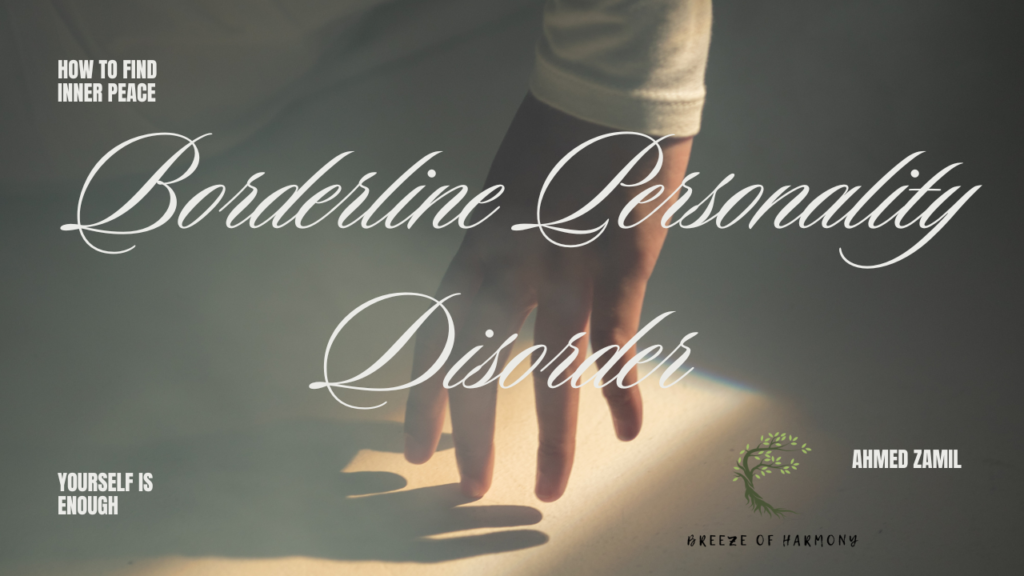Have you ever found yourself navigating the turbulent seas of emotional instability, or perhaps caring for someone who struggles with relationships, self-identity, or intense emotions? If so, you’re not alone. Borderline Personality Disorder (BPD) is a deeply misunderstood mental health condition that impacts millions worldwide. By understanding its traits, you can foster empathy, strengthen relationships, and support those in need.
“Knowing yourself is the beginning of all wisdom.” – Aristotle
What is Borderline Personality Disorder?
Borderline Personality Disorder is a mental health condition characterized by instability in emotions, behavior, relationships, and self-image. At its core lies a deep fear of abandonment and intense emotional fluctuations, making life feel like a constant rollercoaster. While many traits of BPD can resonate with everyone to a small extent, in BPD, they are extreme and persistent, impacting daily life.
In this blog, we’ll explore the nine key traits of BPD and provide insights to help you understand and support those who live with this condition.

1. Fear of Abandonment
“The greatest fear in life is not death; it’s being unloved and abandoned.” – Anonymous
One hallmark trait of BPD is an intense fear of real or perceived abandonment. Even minor events, like a loved one running late, can trigger overwhelming emotions. This fear often leads to behaviors aimed at preventing abandonment but ironically may push people away.
How it Feels:
- Hypervigilance to signs of neglect.
- Fearful thoughts such as, “They’re going to leave me.”
- Preemptive actions like accusations or intense reactions.
Takeaway:
Building consistent and transparent communication can help ease the fear of abandonment in loved ones with BPD.
2. Unstable and Intense Relationships
“A relationship without trust is like a car without gas. You can stay in it, but it won’t go anywhere.”
BPD relationships often resemble a rollercoaster. Intense closeness alternates with severe conflict, creating instability in connections—be it with partners, family, or friends.
Characteristics:
- Relationships may begin with idealization and end in devaluation.
- Constant emotional highs and lows.
- Frequent arguments fueled by insecurity.
Takeaway:
Patience, empathy, and boundary-setting can transform these relationships into healthier dynamics.
3. Identity Disturbance
“Who am I? That’s the greatest question one can ask themselves.” – Socrates
People with BPD often struggle with a shifting sense of self. This “identity disturbance” leads to confusion about personal values, goals, and preferences.
Common Signs:
- Frequently changing appearance, hobbies, or even names.
- Feeling empty or lost.
- Adopting different personas in various situations.
Takeaway:
Encouraging mindfulness and self-reflection can help individuals with BPD explore and embrace their true selves.
4. Impulsivity
“Act in haste, repent at leisure.” – English Proverb
Impulsive behaviors—whether it’s binge eating, shopping sprees, or risky actions—are common in BPD. These actions often serve as temporary coping mechanisms but lead to long-term consequences.
Examples:
- Spending beyond means.
- Substance misuse.
- Engaging in unsafe or reckless behaviors.
Takeaway:
Encouraging healthier coping strategies can help individuals manage impulsive tendencies.
5. Recurrent Suicidal Behavior or Self-Harm
“The darkest moments can lead to the brightest awakenings.” – Unknown
Individuals with BPD are at a higher risk of self-harm or suicidal thoughts. These behaviors often stem from overwhelming emotions or fears of abandonment.
What It Looks Like:
- Self-injury, such as cutting.
- Frequent suicide attempts or threats.
- Feelings of hopelessness.
Takeaway:
Immediate professional support and ongoing therapy, like Dialectical Behavior Therapy (DBT), can make a significant difference.
6. Emotional Instability
“You can’t stop the waves, but you can learn to surf.” – Jon Kabat-Zinn
Rapid mood shifts are a core symptom of BPD. Someone may feel joyful one moment and devastated the next, often in response to minor triggers.
Signs:
- Dramatic emotional reactions.
- Difficulty regulating emotions.
- Feeling consumed by current feelings.
Takeaway:
Practices like mindfulness and emotional regulation techniques can help stabilize moods over time.
7. Chronic Feelings of Emptiness
“It is not the stars to hold our destiny but in ourselves.” – Shakespeare
People with BPD often describe an inner void or a sense of being hollow. This emptiness can lead to a constant search for external validation or stimulation.
Manifestations:
- Seeking attention or reassurance.
- Turning to distractions like shopping or eating.
- Difficulty finding purpose or meaning.
Takeaway:
Fostering a sense of purpose through goals, hobbies, or therapy can help fill this emotional void.
8. Intense and Inappropriate Anger
“Speak when you are angry, and you will make the best speech you’ll ever regret.” – Ambrose Bierce
Anger in BPD can be sudden, intense, and disproportionate to the situation, often leaving loved ones walking on eggshells.
Behaviors:
- Yelling, throwing objects, or becoming physically aggressive.
- Regret and shame following outbursts.
- Difficulty controlling temper.
Takeaway:
Anger management strategies and therapy can help individuals express frustration in healthier ways.
9. Stress-Induced Paranoia or Dissociation
“In times of stress, the best thing we can do for ourselves is to breathe and remain present.” – Unknown
Under stress, individuals with BPD may experience paranoia or dissociation, feeling disconnected from reality or themselves.
Symptoms:
- Feeling others are out to get them.
- Experiencing hallucinations or hearing voices.
- Detaching emotionally or mentally.
Takeaway:
Grounding exercises and professional intervention can help manage these episodes.
Final Thoughts
Living with or supporting someone with BPD is undoubtedly challenging, but it’s not insurmountable. Empathy, patience, and informed strategies can make a world of difference.
“We don’t have to do all of it alone. We were never meant to.” – Brené Brown
Key Takeaways:
- BPD is characterized by emotional, behavioral, and relational instability.
- The nine traits are: fear of abandonment, unstable relationships, identity disturbance, impulsivity, suicidal tendencies, emotional instability, emptiness, intense anger, and stress-induced paranoia/dissociation.
- Treatment, particularly Dialectical Behavior Therapy (DBT), can help individuals manage symptoms effectively.
- Compassion and understanding are crucial in supporting someone with BPD.
Let’s create a world where mental health struggles are met with understanding, not judgment. Together, we can build a bridge to healing and harmony.

